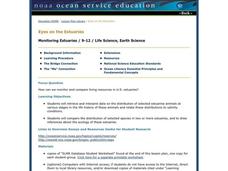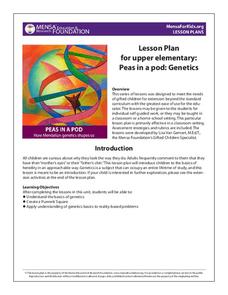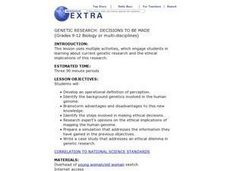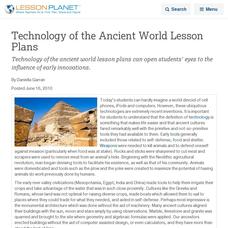Curated OER
The Civil War: Through the Eyes of Hoosier Women-
Fourth graders explain and analyze changes and interactions of Hoosier women in major social and work roles during the Civil War. They recognize and compare the contributions of both women on the home and war fronts.
Curated OER
"An Eye For An Eye, A Tooth For A Tooth"
Sixth graders debate their reactions to two different historical documents about managing a society. In this U.S. history lesson, 6th graders read two articles on codes and laws from different time periods and debate their...
Curated OER
Eyes on the Estuaries
Students study estuaries and compare several ones in the U.S. In this estuary lesson students interpret data and compare the distribution of different species.
Curated OER
For Your Eyes Only
Learners identify two major types of visible pollutants, smog, and particulate matter, They explain that air pollutants are generated during incomplete combustion. They measure and rank collectors from the most pollutants to the least...
Curated OER
The Human Mind
Young scholars read and discuss twin studies to explore the debate of nature vs. nurture. They create a list of characteristics and then look for evidence of whether it is primarily a genetic or environmental characteristic. All of the...
Curated OER
Africa: Beauty is in the Eye of the Beholder
Pupils will create a poster showing how two different cultures strive for beauty. This lesson combines art and social studies in a meaningful way.
Curated OER
Stereotypes: More Than Meets the Eye
Students explore the concept of stereotyping. They observe images and media that portray the Middle East and its inhabitants. Students make determinations about the impact of the images on their perceptions. They consider ways to...
Curated OER
Paper Architecture - Designing Human Spaces
Middle schoolers design, then construct an architectural structural model of a two-person dwelling. Then, Students, in groups, plan a city layout.
Curated OER
Ethos, Logos, and Pathos in Civil Rights Movement Speeches
Examine three speeches while teaching Aristotle's appeals. Over the course of three days, class members fill out a graphic organizer about ethos, pathos, and logos, complete an anticipatory guide, read speeches by Martin Luther King Jr.,...
Curated OER
No Title
Sixth graders explore, analyze and explain self concept and five ways that alcohol harms the body. They assess the relationship between positive health behaviors and the prevention of injury, illness, disease, and other health problems.
MENSA Education & Research Foundation
Peas in a Pod: Genetics
Can peas have grandparents? Learn about inherited traits and heredity with a set of activities focused on Mendelian genetics. As your class learns about the process of passing traits along in Punnett squares, they take on the role of...
Teach Engineering
Get the Word Out at McDonald's!
To get the word out that the Great Pacific garbage patch (GPGP) contains millions of pounds of non-biodegrading plastics, individuals research the GPGP and write an article for a newsletter. Researchers present their facts in a...
Curated OER
Emerging Viruses
Students study the characteristics of living things and explore the characteristics of viruses including their structure, function, and reproductive cycles. They also explore the impact of viruses on human health by discussing common...
Curated OER
Segregation
Students consider the implications of prejudice. In this segregation lesson, students experience a simulation that has school staff favoring students with blue eyes. Students discuss the simulation experience, watch "The Eye of the...
Curated OER
The Empirical Challenges of Racial Classification
This lesson plan will help students examine their preconceptions and assumptions about racial categories and understand the impossibility of constructing a consistent system of human racial classification.
Curated OER
Heredity Mix 'n Match
Students randomly select jelly beans that represent genes for several human traits such as tongue-rolling ability and eye color. Then, working in pairs (preferably of mixed gender), students randomly choose new pairs of jelly beans from...
Curated OER
Expressive Papier-Mache Masks
Students create papier-mache masks showing different human emotions. In this mask lesson, students choose what facial expression they want and sketch out their mask and background. They form the "face" in clay and then papier-mache over...
Curated OER
Mexican "Tona" Animal Masks
Students study the Mexican legend related to masks. They select an animal with traits they can identify with and recognize in themselves. Afterward, they create a mask that will retain some human features, but take on the life of the...
Curated OER
Review of the Five Senses
Students investigate the five senses. In this human biology lesson, students are given five items and identify which items match best with each of the senses. Students use objects such as a rock, hard candy, and a flower.
Curated OER
Genetic Research: Decisions to be Made
Students examine the genetics involved in the human genome. They brainstorm the advantages and disadvantages to this discovery. They research different experts opinion and write a case study which addresses an ethical dilemma.
Curated OER
Politics and the Olympics
Students discover details regarding Olympics controversies. In this international politics instructional activity, students research Olympic games of the Modern Era noting the controversies surrounding Beijing Olympics. Students create...
Curated OER
People and the Environment
For this environment worksheet, students look at how different human actions can cause pollution and how the pollution effects the environment. This worksheet has 6 short answer questions.
Curated OER
Technology of the Ancient World Lesson Plans
Technology of the ancient world lesson plans can open students' eyes to the influence of early innovations.
Curated OER
If I Could Talk Like the Animals. . .
Students read and discuss a film review of the animated movie Antz and then write a monologue from the perspective of a non-human organism.























